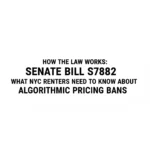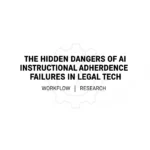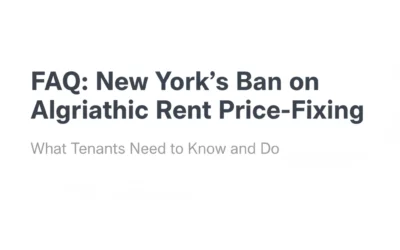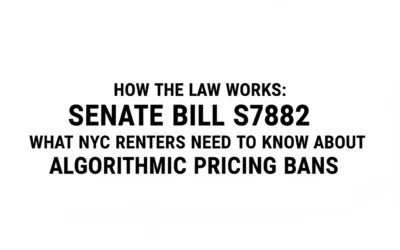In the evolving landscape of legal technology, artificial intelligence stands as both harbinger of unprecedented efficiency and architect of subtle professional peril. As law firms increasingly integrate AI systems into their daily operations, a critical yet underexamined vulnerability emerges: instructional adherence failures that threaten the very foundation of legal practice through their insidious capacity to corrupt both research accuracy and workflow integrity.
The legal profession finds itself at a crossroads where traditional notions of professional competence intersect with technological sophistication, creating new paradigms of risk that demand immediate attention and strategic response. These failures represent more than mere technical glitches, they constitute fundamental breaches in the covenant between practitioner and client, between advocate and justice system, between the promise of technological enhancement and the reality of professional responsibility.
The Architecture of Instructional Adherence Malfunction
Instructional adherence malfunction occurs when artificial intelligence systems deviate from their programmed directives or user instructions, producing outputs that appear professionally competent while harboring critical flaws in execution, interpretation, or foundational accuracy. Unlike overt technical failures that announce themselves through obvious malfunction, these subtle deviations present themselves wrapped in the veneer of professional competence, complete with authoritative language, proper formatting, and compelling argumentation.
The insidious nature of these failures lies in their presentation of what experts describe as the "illusion of AI infallibility", outputs that possess all the hallmarks of competent legal work while concealing fundamental errors beneath layers of professional polish. This phenomenon has transformed the practice of law into a minefield where even experienced practitioners can find themselves unwittingly relying upon fabricated authority, fictitious precedents, and systematically flawed analysis.
Recent documentation reveals an epidemic of AI-driven legal hallucinations, with more than 300 documented cases since mid-2023, including at least 200 recorded in 2025 alone. This staggering proliferation represents a transformation from isolated incident to systematic professional crisis, with federal courts imposing sanctions on attorneys across multiple jurisdictions including Arizona, Louisiana, Florida, and internationally in the United Kingdom, Australia, Canada, and Israel.
The Research Domain: Fabrication Masquerading as Authority
In the realm of legal research, instructional adherence failures manifest as fabricated legal authority that seamlessly integrates within otherwise accurate analysis. AI systems generate compelling case citations referencing non-existent court decisions, create plausible-sounding legal precedents with no foundation in actual jurisprudence, and craft sophisticated legal arguments built entirely upon fictitious foundations.
The fabrication extends beyond simple citation errors to encompass entirely fictional legal doctrines, misstated statutory requirements, and generated procedural rules that possess authoritative tone yet lack any basis in established law. When these fabrications appear within professionally formatted documents alongside legitimate legal analysis, even seasoned practitioners can overlook fictitious elements during routine review processes.
The professional competence crisis intensifies because attorneys who submit briefs containing non-existent case law face sanctions, professional embarrassment, and client lawsuits despite having no intent to deceive courts. Even when utilizing established legal research databases like Westlaw Precision, tools specifically designed for legal research, practitioners continue to submit hallucinated citations, highlighting that the problem transcends individual AI tools to encompass fundamental verification responsibilities.
Workflow Platforms: The Cascade of Systematic Corruption

Multi-AI workflow platforms present an even more pernicious threat through their capacity for systematic process degradation. Unlike research applications where errors remain relatively contained within individual documents, workflow malfunctions create cascading failures that propagate throughout entire case management processes, document preparation sequences, and client communication protocols.
The cascading nature of these failures creates a domino effect where a single instructional adherence malfunction in one AI agent ripples through interconnected systems, amplifying errors exponentially. Consider a contract drafting workflow where the initial AI fails to adhere to instructions regarding specific indemnity language: subsequent AI agents build upon this flawed foundation, creating compliance review failures, filing automation errors, and client communication discrepancies that may not surface until critical deadlines have passed or regulatory violations have occurred.
Workflow-specific risks encompass the propagation of errors across multiple cases when AI systems consistently misinterpret standard operating procedures, the creation of systematic compliance failures when automated systems deviate from regulatory requirements, and the introduction of bias patterns that remain invisible until widespread implementation has already compromised client matters across the firm's entire practice.
The operational nature of workflow platforms creates over-reliance and complacency, as busy practitioners automate routine tasks without implementing rigorous oversight protocols. Unlike research outputs that undergo deliberate review, workflow processes operate in the background, mimicking human procedures while lacking the transparency necessary for effective quality control.
The Professional Competence Crisis: Accountability in the Age of Automation
State bar associations nationwide have established unambiguous standards: attorneys who rely on AI tools without adequate supervision and verification face the same disciplinary consequences as those who submit inadequate work produced entirely through human effort. The technology may represent innovation, but professional standards remain unforgiving, creating urgent demand for sophisticated quality control systems that match the complexity of modern AI integration.
Courts are now distinguishing between "intentional deception" and "inadvertent reliance on AI," though both scenarios can result in sanctions. This emerging liability framework suggests that professional standards are evolving to address both AI proficiency and independent practice capabilities, creating new competency requirements that extend beyond traditional legal knowledge to encompass technological literacy and verification expertise.
The fundamental reality remains that practitioners, not their technological tools, bear ultimate responsibility for work product integrity. This principle applies regardless of whether work emerges from traditional research methods or sophisticated AI processing, establishing a professional imperative that transcends technological innovation to embrace enduring principles of competent representation.
Emerging Standards and Strategic Mitigation
The conscious collaboration model represents the most promising approach to managing instructional adherence failures, involving systematic utilization of AI capabilities while preserving human judgment and professional competency. This framework requires treating AI outputs as preliminary research demanding comprehensive human validation rather than finished products, implementing specialized review protocols that target common AI failure patterns, and developing expertise in AI evaluation rather than merely operating AI systems.
Successful mitigation strategies must address the widespread nature of AI dependency as a cross-professional risk requiring deliberate policy development and continuous competency maintenance. Law firms must implement robust guardrails including mandatory instruction logging, configurable adherence verification systems, and hybrid approaches that pair AI capabilities with human oversight at every critical juncture.
The path forward demands more than procedural safeguards, it requires fundamental recommitment to core principles of professional responsibility, client advocacy, and justice system integrity. As we navigate this technological transformation, the legal profession must embrace both innovation and accountability, ensuring that technological advancement serves justice rather than compromising its foundation.
Instructional Adherence, Side-by-Side: GenAI Research vs. AI Employee Ecosystems
Leaders must recognize that instructional adherence fractures along two distinct fault lines: the solitary rigor of GenAI-assisted legal research and the networked complexity of AI “employee” ecosystems that orchestrate intake, drafting, review, and client communication. One is a precision instrument that can misquote the law while wearing the robe of authority; the other is a distributed assembly line where a single skipped step can reverberate across the firm’s operations. Both demand vigilance. Each demands a different governance posture.
- GenAI for Legal Research: where authority can be fabricated behind polished prose
- Primary adherence challenges:
- Hallucinated citations or quotations that look Bluebook-perfect but anchor to nothing.
- Jurisdiction drift that blends federal and state authorities or imports out-of-circuit rules.
- Overconfident synthesis that omits controlling precedent or misstates procedural posture.
- Failure signatures:
- Nonexistent docket numbers; case names that fit patterns but resist retrieval.
- Pin cites that do not align with official reporters; quotations without parallel citations.
- Example in practice:
- A motion includes a persuasive “Appellate Division” holding that cannot be Shepardized/KeyCited, slipping through initial review because formatting appears impeccable. Exposure surfaces when opposing counsel challenges the authority, risking sanctions and reputational harm.
- Leadership levers and metrics:
- Controls: mandatory source retrieval, citation validators, “no-new-law” prompts, jurisdiction locks.
- Metrics: hallucination rate per memo, percent sources verified, jurisdiction mismatch rate, detection latency.
- Primary adherence challenges:
- AI Employee Ecosystems: where process fidelity can quietly erode across connected agents
- Primary adherence challenges:
- Step-skipping in multi-agent workflows (e.g., indemnity clause checks, conflicts clearance).
- Role confusion and instruction drift between agents using different, stale SOP versions.
- Context decay across handoffs that mutates client constraints or filing deadlines.
- Failure signatures:
- Consistently formatted outputs with systematically omitted clauses; parallel matters exhibiting identical deviations; adherence logs with gaps at critical checkpoints.
- Example in practice:
- An intake classifier mislabels a matter type; downstream drafting omits required consumer disclosures; automated e-filing calendars the wrong deadline across a docket set. The deviation comes to light only after a pattern of client questions or a missed compliance milestone.
- Leadership levers and metrics:
- Controls: versioned SOPs, agent-to-agent “contract tests,” gated handoffs with sign-offs, canary matters, kill-switch and rollback procedures.
- Metrics: step-adherence score by workflow, SLA breach rate, cross-matter blast radius, mean time to rollback.
- Primary adherence challenges:
Summary table for decision-makers:
| Dimension | GenAI Legal Research | AI Employee Ecosystems |
|---|---|---|
| Scope of impact | Single memorandum, brief, or motion; localized | Multi-matter, cross-workstream; systemic |
| Error visibility | Moderate if sources are verified; low if prose is polished | Low until KPIs slip or clients complain |
| Primary adherence risk | Fabricated or mis-scoped authority | Step-skipping, role confusion, stale SOPs |
| Verification method | Source-of-truth retrieval; citation validation; Shepardize/KeyCite | Process audits; checkpoint logs; contract tests between agents |
| Time-to-detect | Hours–days with disciplined review | Days–weeks; often post-incident |
| Downstream risk | Sanctions, court admonitions, credibility damage | Widespread compliance failures; deadline breaches |
| Governance owner | Matter lead and research supervisor | Operations leadership and risk/compliance |
| Key controls | “No-new-law” prompts; jurisdiction locks; mandatory cross-checks | Versioned SOPs; gated handoffs; canaries; kill-switch |
| Fallback protocol | Withdraw/revise filing; rework memo | Halt-and-triage; rollback to human-only workflow firmwide |
Leadership takeaway: Treat GenAI research outputs as drafts that must earn their authority through verification, and treat AI employee ecosystems as a supply chain that must prove each handoff through evidence. Awareness and disciplined governance are paramount. If your team encounters potential exposure from AI adherence lapses, prompt escalation, meticulous documentation, and immediate containment are not optional—they are the line between recoverable error and systemic failure.
The Imperative for Strategic Action
The hidden dangers of AI instructional adherence failures demand immediate, comprehensive response from legal practitioners, firms, and the broader professional community. These failures represent more than technical challenges, they constitute threats to the integrity of legal representation, the reliability of judicial proceedings, and the trust that forms the cornerstone of attorney-client relationships.
As leaders in the legal profession, we must acknowledge these risks while embracing the transformative potential of artificial intelligence. The future of legal practice lies not in avoiding technological innovation but in implementing it with wisdom, vigilance, and unwavering commitment to professional excellence.
The choice before us is clear: we can allow instructional adherence failures to undermine our profession, or we can rise to meet this challenge with the same dedication to justice that has defined legal practice throughout its history. The path to responsible AI integration begins with recognition of these hidden dangers and commitment to the rigorous standards that protect both our clients and our profession.
Roland G. Ottley, Esq.
The Ottley Law Firm, PC
1063 Winthrop Street
Brooklyn, NY 11212
(718) 221-2162 Office
(718) 221-2164 Fax
[email protected]
www.theottleylawfirm.com









0 Comments